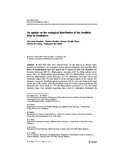Please use this identifier to cite or link to this item:
https://cris.library.msu.ac.zw//handle/11408/678Full metadata record
| DC Field | Value | Language |
|---|---|---|
| dc.contributor.author | Sungirai, Marvelous | - |
| dc.contributor.author | Madder, Maxime | - |
| dc.contributor.author | Moyo, Doreen Zandile | - |
| dc.contributor.author | De Clercq, Patrick | - |
| dc.contributor.author | Nji Abatih, Emmanuel | - |
| dc.date.accessioned | 2015-09-18T09:44:18Z | - |
| dc.date.available | 2015-09-18T09:44:18Z | - |
| dc.date.issued | 2015-02 | - |
| dc.identifier.issn | 0168-8162 (Print) 1572-9702 (Online) | - |
| dc.identifier.uri | http://hdl.handle.net/11408/678 | - |
| dc.description.abstract | In total 7657 ticks were collected from 121 dip tanks in 12 districts repre- sentative of Zimbabwe’s five ecological regions between September 2013 and May 2014. Based on morphological traits four genera and 13 species of ticks were identified. Am- blyomma hebraeum (60.3 %), Rhipicephalus microplus (58.7 %), Rhipicephalus decol- oratus (47.1 %), Rhipicephalus appendiculatus (56.2 %), Rhipicephalus evertsi evertsi (67.8 %), Rhipicephalus (near) punctatus (13.2 %), Hyalomma truncatum (38 %) and Hyalomma rufipes (46.3 %) were found in all the ecological regions of the country. Am- blyomma variegatum and Rhipicephalus compositus (0.8 %) were only found in the north central part of the country while Rhipicephalus simus (5 %) had a sparse distribution. The Haemaphysalis leachi group (1.7 %) and Rhipicephalus sanguineus (1.7 %) were found whenever dogs were sampled suggesting these could be widespread throughout the country. The study confirmed the continued limited distribution of A. variegatum (3.3 %) in the north central parts of the country, whereas A. hebraeum was found to have a wide distribution also encroaching areas of high rainfall and lower temperatures where it was not previously recorded. A parapatric relationship existed between these two Amblyomma species. Rhipicephalus appendiculatus was also widely distributed although its presence was dominant in the cooler and wetter parts of the country. The traditionally held view that Hyalomma species and R. evertsi evertsi can survive well under diverse conditions is upheld in this study. Rhipicephalus microplus was also present in dry regions but its adaptability to these regions requires further investigation. | en_US |
| dc.language.iso | en | en_US |
| dc.publisher | Springer International Publishing | en_US |
| dc.relation.ispartofseries | Experimental and Applied Acarology; | - |
| dc.subject | Ticks, ecology, distribution, Zimbabwe | en_US |
| dc.title | An update on the ecological distribution of the Ixodidae ticks in Zimbabwe | en_US |
| dc.type | Article | en_US |
| item.grantfulltext | open | - |
| item.languageiso639-1 | en | - |
| item.openairetype | Article | - |
| item.fulltext | With Fulltext | - |
| item.cerifentitytype | Publications | - |
| item.openairecristype | http://purl.org/coar/resource_type/c_18cf | - |
| Appears in Collections: | Research Papers | |
Files in This Item:
| File | Description | Size | Format | |
|---|---|---|---|---|
| abstract.pdf | 36.47 kB | Adobe PDF |  View/Open |
Items in MSUIR are protected by copyright, with all rights reserved, unless otherwise indicated.



